Papers by Thomas Aparicio
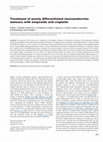
British journal of cancer, 1999
The purpose of this study was to evaluate by a retrospective analysis of 53 patients the efficacy... more The purpose of this study was to evaluate by a retrospective analysis of 53 patients the efficacy of chemotherapy combining etoposide and cisplatin in the treatment of neuroendocrine tumours. The regimen was a combination of etoposide 100 mg m(-2) day(-1) for 3 days and cisplatin 100 mg m(-2) on day 1, given by 2-h intravenous infusion, administered every 21 days. Twelve patients had a well-differentiated and 41 a poorly differentiated neuroendocrine tumour. Toxicity of treatment was assessed in 50 patients and efficacy in 52 patients. Among the 11 patients with a well-differentiated tumour evaluable for tumoural response, only one (9.4%) had a partial response for 8.5 months. Forty-one patients with a poorly differentiated tumour showed an objective response rate of 41.5% (four complete and 13 partial responses); the median duration of response was 9.2 months, the median overall survival 15 months and the median progression-free survival 8.9 months. Haematological grade 3-4 toxicit...

Clinics and research in hepatology and gastroenterology, 2011
The most commonly used schedules are 5-FU in combination with CDDP with or without epirubicin (EC... more The most commonly used schedules are 5-FU in combination with CDDP with or without epirubicin (ECF) or docetaxel (TCF) in treatment of MGA patients (pts), independently of HER status. We evaluated the efficacy of FOLFIRI regimen in a large retrospective series of MGA pts. Two hundred and twelve pts from 13 French centers were treated with at least one cycle of FOLFIRI (irinotecan 180 mg/m2 intravenous (i.v.) over 90 minutes on day 1 with folinic acid (FA) 400mg/m2 i.v. over two hours followed by 5-FU 400mg/m2 i.v. bolus then 5- FU 2400 mg/m2 continuous infusion over 46 hours on day 1, repeated every 14 days). Primary tumour sites were 120 (58%) stomach and 92 (42%) gastroesophageal junction. FOLFIRI was administered as first-line in 137 (65%) pts and as later-line in 75 (35%) pts for MGA. There was no difference between chemonaive and not chemonaive pts treated as firstline in terms of response rate 37% (95% CI: 25-50) vs 44% (95% CI: 21-69), median PFS, 6.7 (95% CI: 5.5-9.9) vs 5.3...
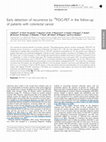
British journal of cancer, Jan 11, 2008
We assessed the potential benefits of including systematic 18fluorodeoxyglucose positron emission... more We assessed the potential benefits of including systematic 18fluorodeoxyglucose positron emission tomography (FDG-PET) for detecting tumour recurrence in a prospective randomised trial. Patients (N=130) who had undergone curative therapy were randomised to undergo either conventional (Con) or FDG-PET procedures during follow-up. The two groups were matched at baseline. Recurrence was confirmed histologically. 'Intention-to-treat' analysis revealed a recurrence in 46 patients (25 in the FDG-PET group, and 21 in the Con group; P=0.50), whereas per protocol analysis revealed a recurrence in 44 out of 125 patients (23 and 21, respectively; P=0.60). In another three cases, PET revealed unexpected tumours (one gastric GIST, two primary pulmonary cancers). Three false-positive cases of FDG-PET led to no beneficial procedures (two laparoscopies and one liver MRI that were normal). We failed to identify peritoneal carcinomatosis in two of the patients undergoing FDG-PET. The overall ...
Annals of Oncology, 2006
adenocarcinoma were treated with the FOLFIRI.3 regimen, consisting of irinotecan 90 mg/m2 as a 60... more adenocarcinoma were treated with the FOLFIRI.3 regimen, consisting of irinotecan 90 mg/m2 as a 60-min infusion on day 1, leucovorin 400 mg/m2 as a 2-h infusion on day 1, followed by 5-fluorouracil (5-FU) 2000 mg/m2 as a 46-h infusion and irinotecan 90 mg/m2, repeated on day 3, at the end of the 5-FU infusion, every 2 weeks. Results: Forty patients
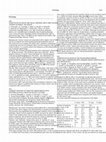
International Journal of Antimicrobial Agents, 2009
Background: Colonic tumors are associated with a higher rate of SbFC and an increased risk of Sb ... more Background: Colonic tumors are associated with a higher rate of SbFC and an increased risk of Sb bacteremia/endocarditis. The aims of this study were to re-assess the SbFC rate in patients undergoing a colonoscopy and the link between SbFC and the frequency and type of colonic lesions, in a country where the frequency of Sb endocarditis has increased significantly. Methods: We enrolled 268 adult patients who underwent colonoscopy for whatever reason. The following data were collected: demographics, history of colonic tumor, indication for colonoscopy, and colonoscopy/pathology diagnosis. The latter was distributed into 3 classes: normal, tumoral lesion (adenoma/carcinoma), and nontumoral anomaly. Before colonoscopy, stool samples were collected, frozen and centralized. After thawing, several dilutions were plated onto a semi-selective agar medium. All Gram positive, catalase and PYR negative colonies were identified using the API 20 Strep system (bioMérieux) and by sodA gene sequencing. Results: After exclusion of 9 patients (missing data), 259 cases (131 men, mean age 59.5 years, range 22 90), were analyzed. 52 patients had tumoral lesions (48 adenomas, 4 carcinomas). The SbFC rate was 4.6% (12/259). Species distribution was: S. infantarius subsp. coli (n = 9), S. gallolyticus subsp. pasteurianus (n = 2), and S. gallolyticus subsp. gallolyticus (n = 1). SbFC was more frequent in patients with history of tumor (10.5% vs. 3.0%, p = 0.03) but not in patients with current tumor (6.1% vs. 4.3, p = 0.7). Conclusions: SbFC rate was lower than anticipated. However it was found to be higher in patients with history of colonic tumor, but not in patients with current tumor.

Critical Reviews in Oncology Hematology, 2008
Introduction: Older cancer patients may not receive optimal treatment because of limited data ava... more Introduction: Older cancer patients may not receive optimal treatment because of limited data available to guide decision-making. Therefore, it remains challenging for oncologists to predict who can tolerate treatment and which older cancer patient is at risk for complications. The concept of frailty may be a useful way to characterize vulnerability, in order to optimize treatment for older cancer patients. Objective: To describe the health and vulnerability of older cancer patients and the adverse outcomes of treatment. Study design: The pilot study is an observational prospective cohort study. The baseline interview with the older cancer patient is conducted before the start of treatment. A second face-to-face interview is conducted after 3 months and a third at 6 months later. At both follow-ups, the oncology data and data on treatment toxicity will be abstracted from the medical chart. In addition, patients will also be called at 1.5 and 4.5 months after baseline to administer a short questionnaire on self-report of functional status and treatment toxicity. Study Population: Older cancer patients referred to the Jewish General Hospital, aged 65 and older with a new diagnosis of solid tumor with or without metastasis (breast, colorectal or lung cancers) or hematological malignancy (lymphoma or myeloma). Individuals unable to speak French or English, with a life expectancy estimated at less than three months or not able to give informed consent, or who received cancer treatment in the previous five years are ineligible. Methods: Data is being collected on demographics, on health, functional status, frailty markers, lifestyle factors, pain, social support, and quality of life. In this study the outcome measures include: change in health and functional status and treatment toxicity, discontinuation of treatment, hospitalization/ emergency room visit, and use of home health care services. Results: 112 patients are included (response rate 74%). The mean age is 73.7 years, 78 women and 34 men. 58% of patients were born in Canada, 74% has a caregiver available. The proposed treatment plans for the majority of patients is surgery (50%) and chemotherapy (30%). At baseline 12 patients have 0 frailty markers, mean number of frailty markers at baseline is 2.0. The most prevalent frailty markers at baseline are mobility impairment (49%), nutrition deficit (41%) and physical inactivity (38%), followed by low energy/endurance (28%), cognitive impairment (23%), mood impairment (23%) and low grip strength (20%). 36 patients have IADL disability and 7 ADL disability at baseline. Conclusion: The majority of older newly diagnosed cancer patients have 1 or more frailty markers but no ADL disability at baseline. This pilot study will help to the best design of a large prospective cohort study on health and functional status in older newly-diagnosed cancer patients.
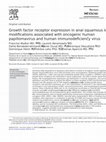
Human Pathology, 2009
High prevalence of squamous anal lesions is linked to oncogenic human papillomavirus (HPV). Human... more High prevalence of squamous anal lesions is linked to oncogenic human papillomavirus (HPV). Human immunodeficiency virus (HIV) promotes anal carcinogenesis. Epidermal growth factor receptor (EGFR), HER2/neu, c-Met, and vascular endothelial growth factor receptor-1 (VEGFR1) (tyrosine kinase growth factor receptors) are implicated in tumor progression, but little is known about their role in anal lesions. We investigated their expression and distribution in normal, dysplastic, and carcinomatous anal epithelium and then tried to analyze the effects on these variables of HPV and the HIV-positive status. Seventy-one HIV-positive and 47 HIV-negative patients were selected. We studied growth factor receptors, p16 and Ki67 expression, by in situ hybridization, fluorescent in situ hybridization (FISH) and chromogen in situ hybridization (CISH), immunocytochemistry, and morphological quantification in 226 lesions, either infected by HPV6 and 11 (31 condylomas acuminata) or infected with oncogenic HPVs (48 invasive cancers, 147 anal intraepithelial neoplasias). No HER2/neu was detected. Strong EGFR immunolabeling was not accompanied by gene amplification. The number and intensity of EGFR-and c-Met-immunoreactive cells increased significantly during lesion progression, highlighting the effects of oncogenic HPVs. EGFR, c-Met, VEGFR1, and p16 were coexpressed in 96% of invasive cancers. HIVmodified c-Met expression in condyloma acuminata (P b.008) and invasive cancers (P b.02). Strong HIVrelated immunodeficiency and an absence of antiretroviral therapy increased c-Met and/or EGFR expression. HIV-positive anal cancers showed correlated c-Met and VEGFR1 (P b .003), strong p16 labeling, and an increased Ki67 proliferation. The finding that EGFR, c-Met, and VEGFR1 involved in carcinogenesis are well-represented and coexpressed in anal cancers, especially in HIV-positive population, suggests possible novel targeted treatments for anal diseases.
Cancéro digest, 2009
ABSTRACT Un essai randomisé comparant octréotide et absence de traitement spécifique chez des mal... more ABSTRACT Un essai randomisé comparant octréotide et absence de traitement spécifique chez des malades atteints de carcinome hépatocellulaire (CHC) évolué avait précédemment montré un bénéfice en termes de survie globale chez les patients traités [1]. Le but de l’étude ici relatée a été d’évaluer ce bénéfice dans un essai randomisémulticentrique incluant un nombre suffisant de patients.

Journal of clinical oncology : official journal of the American Society of Clinical Oncology, 2014
To compare epirubicin, cisplatin, and capecitabine (ECX) with fluorouracil, leucovorin, and irino... more To compare epirubicin, cisplatin, and capecitabine (ECX) with fluorouracil, leucovorin, and irinotecan (FOLFIRI) as first-line treatments in patients with advanced gastric or esophagogastric junction (EGJ) adenocarcinoma. This open, randomized, phase III study was carried out in 71 centers. Patients with locally advanced or metastatic gastric or EGJ cancer were randomly assigned to receive either ECX as first-line treatment (ECX arm) or FOLFIRI (FOLFIRI arm). Second-line treatment was predefined (FOLFIRI for the ECX arm and ECX for the FOLFIRI arm). The primary criterion was time-to-treatment failure (TTF) of the first-line therapy. Secondary criteria were progression-free survival (PFS), overall survival (OS), toxicity, and quality of life. In all, 416 patients were included (median age, 61.4 years; 74% male). After a median follow-up of 31 months, median TTF was significantly longer with FOLFIRI than with ECX (5.1 v 4.2 months; P = .008). There was no significant difference betwee...
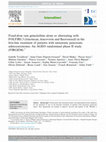
European journal of cancer (Oxford, England : 1990), 2014
Fluorouracil and irinotecan-based, and gemcitabine-based regimens, are the standard of care in th... more Fluorouracil and irinotecan-based, and gemcitabine-based regimens, are the standard of care in the first-line treatment of patients with metastatic pancreatic cancer. New approaches are needed to improve survival and quality of life. Whether a sequential approach alternating irinotecan, fluorouracil and gemcitabine may be effective and tolerable in patients with metastatic pancreatic cancer is unknown. In this randomised, multicentre, open-label, phase 2 trial, patients with metastatic pancreatic adenocarcinoma, World Health Organisation (WHO) performance status 0-1, and bilirubin levels <1.5 upper limit of normal values (ULN) were randomised 1:1 to receive as first-line treatment either FOLFIRI.3 (irinotecan, leucovorin and fluorouracil) alternating with fixed-dose rate gemcitabine as 2-month periods (FIRGEM, arm A), or fixed-dose rate gemcitabine alone (arm B). Treatment was continued until disease progression or limiting toxicity. The primary end-point was the crude progressio...
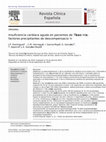
Revista Clínica Española, 2010
Acute heart failure in patients over 70 years of age: Precipitating factors of decompensation Abs... more Acute heart failure in patients over 70 years of age: Precipitating factors of decompensation Abstract Objectives: Heart failure decompensation is the most common reason for hospitalization in persons over 65 years old. There is limited information on the prevalence of precipitating factors of heart failure decompensation in this population. In this study we prospectively examined the factors associated with decompensation of heart failure in patients over 70 years of age. Material and methods: During the 36 months from January 2006 to December 2008, we included 386 patients over 70 years of age that were admitted through emergencies with these three criteria: Dyspnea (class III or IV of the New Yourk Heart Association), pulmonary edema and echocardiographic data of left ventricular systolic or diastolic dysfunction. Results: The mean age of the patients was 82 years and 58.5% were female. Left ventricular systolic dysfunction was diagnosed in 41.2% of them. We identified one or more precipitating factors of heart failure decompensation in 89.6% of the patients. The most common were atrial tachyarrhythmia (22.3%), respiratory infection (21.2%), severe anemia (17.1%), acute renal failure (12.7%), severe hypoalbuminemia (11.4%) and acute coronary syndrome (9.1%). Fifty-two patients (13.5%) died. The variables independently associated with hospital mortality were acute renal failure, severe hypoalbuminemia, systolic blood pressure o110 mmHg, white blood cell count 410.000 per mm 3 and valvular heart disease. Conclusions: In most patients over 70 years of age hospitalized with acute heart failure it is possible to identify one or more precipitating factors of decompensation, some of which are independently associated with hospital mortality.

European Journal of Cancer, 2014
Small bowel adenocarcinoma (SBA) is a rare and aggressive tumour with poor outcomes. Because of i... more Small bowel adenocarcinoma (SBA) is a rare and aggressive tumour with poor outcomes. Because of its low incidence, the number prospective studies remains insufficient leading to poor knowledge and absence of standard of care. Aiming to better understand small bowel carcinogenesis we investigated the frequency of somatic mutations in a large data set of patients in more than 740 mutational hotspots among 46 genes. In total, 83 SBA cases were selected from two European databases. The sequencing was performed using the Ion 316 Chip. Additionally we looked into ERBB2 expression and microsatellite instability (MSI) status. The tumours most frequently were duodenal (47%) and stage ⩾3 (63%). Eight genes were mutated with a frequency &amp;amp;amp;amp;amp;amp;amp;amp;amp;amp;amp;amp;amp;amp;amp;amp;amp;amp;amp;amp;amp;amp;amp;amp;amp;amp;amp;amp;amp;amp;amp;amp;amp;amp;amp;amp;amp;amp;amp;amp;amp;amp;amp;amp;amp;amp;amp;amp;amp;amp;amp;amp;amp;amp;amp;amp;amp;amp;amp;amp;amp;amp;amp;amp;amp;amp;amp;amp;amp;amp;amp;amp;amp;amp;amp;amp;amp;amp;amp;amp;amp;amp;amp;amp;amp;amp;amp;amp;amp;amp;amp;amp;amp;amp;amp;amp;amp;amp;amp;amp;amp;amp;amp;amp;amp;amp;amp;amp;amp;amp;amp;amp;amp;amp;amp;amp;amp;amp;amp;amp;amp;amp;amp;amp;amp;amp;amp;amp;amp;amp;amp;amp;amp;amp;amp;amp;amp;amp;amp;amp;amp;amp;amp;amp;amp;amp;amp;amp;amp;amp;amp;amp;amp;amp;amp;amp;amp;amp;amp;amp;amp;amp;gt;5%: KRAS, TP53, APC, SMAD4, PIK3CA, ERBB2, BRAF and FBXW7. ERBB2 alterations are present in 10 patients (12%) through mutations (7 cases) or amplifications (3 cases). ERBB2 mutations were significantly associated with duodenal tumour location (P=0.04). In this group, there was a positive association with dMMR status (P=0.006) and APC mutation (P=0.02) but negative association with p53 mutations (P=0.038). This study describes the first large screening of somatic mutations in SBA using next generation sequencing. The ERBB2 mutation was revealed to be one of the most frequent alterations in SBA with a distribution dependent on tumour location. In most cases ERBB2 mutation was identical (p.L755S). In clinical practice, this may suggest that more than 10% of the patients with SBA could be treated using an anti-ERBB2-targeted agent.
PLoS ONE, 2010
Background: Ulcerative Colitis (UC) and Crohn's Disease (CD) are two chronic Inflammatory Bowel D... more Background: Ulcerative Colitis (UC) and Crohn's Disease (CD) are two chronic Inflammatory Bowel Diseases (IBD) affecting the intestinal mucosa. Current understanding of IBD pathogenesis points out the interplay of genetic events and environmental cues in the dysregulated immune response. We hypothesized that dysregulated microRNA (miRNA) expression may contribute to IBD pathogenesis. miRNAs are small, non-coding RNAs which prevent protein synthesis through translational suppression or mRNAs degradation, and regulate several physiological processes.

Oncology, 2011
The possible impact of malnutrition on the tolerability and efficacy of modern chemotherapy regim... more The possible impact of malnutrition on the tolerability and efficacy of modern chemotherapy regimens for metastatic colorectal cancer (mCRC) is unclear. In this prospective, cross-sectional, multicenter study, we collected demographic, oncological and nutritional data for all consecutive mCRC patients during a 14-day period in eight hospitals. Nutritional status was assessed with the nutritional risk index (NRI), and patients were classified as severely malnourished when NRI was &amp;amp;amp;amp;amp;amp;amp;amp;amp;amp;amp;amp;amp;amp;amp;amp;amp;amp;amp;amp;amp;amp;amp;amp;amp;amp;amp;amp;amp;amp;amp;amp;amp;amp;amp;amp;amp;amp;amp;amp;amp;amp;amp;amp;lt;83.5; drug-induced toxicities were evaluated using the National Cancer Institute Common Toxicity Criteria (version 3.0). Survival times were calculated from the date of the nutritional assessment. We enrolled 114 mCRC patients (median age: 65 years, range: 22-92; WHO performance status 0/1/2/3: 21/54/21/4%) of whom 88% had at least 2 metastatic sites and 49% were receiving chemotherapy as first-line treatment. Malnutrition was diagnosed in 65% of the patients and was severe in 19%. Severe malnutrition was associated with more adverse effects following chemotherapy (p = 0.01) and with shorter median overall survival (14.0 vs. 36.2 months in non-/moderately malnourished patients, p = 0.02). In mCRC patients, severe malnutrition is associated with greater chemotherapy toxicity and reduced overall survival.
Obesity Surgery, 2007
Background: Ghrelin, a 28 amino-acid acylated orexigenic peptide secreted by the stomach, acts on... more Background: Ghrelin, a 28 amino-acid acylated orexigenic peptide secreted by the stomach, acts on the hypothalamic arcuate nucleus which stimulates feeding behavior. Serum ghrelin level increases during fasting and decreases after a meal. Serum ghrelin is low in obese patients. Whether ghrelin is implicated in weight loss in obese patients after laparoscopic adjustable gastric banding (LAGB) is still debated. In this study, we assessed serum ghrelin level and gastric fundus expression before and 1 year after LAGB.
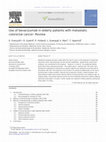
Journal of Geriatric Oncology, 2011
Significant progress has been made within the last 15 years in the treatment of advanced colorect... more Significant progress has been made within the last 15 years in the treatment of advanced colorectal cancer. Bevacizumab, an anti-vascular endothelial growth factor monoclonal antibody, has contributed to this progress. However, in most of the published studies, particularly those using bevacizumab, the median age of patients was < 65 years, thus limiting the availability of information on elderly subjects who represent more than half of all patients with CRC. The objective of this review is to analyze available data on the use of bevacizumab in elderly subjects. Results from prospective studies, pooled analyses, and observational studies have shown that the efficacy of bevacizumab is not related to age. As regards safety, only arterial adverse events are more frequently observed in elderly subjects, especially those aged >75 years. Further studies are required in elderly patients, particularly those aged >75 years.

Gastroentérologie Clinique et Biologique, 2004
To evaluate the diagnosis, treatment and outcome of patients with pancreatic metastases. We retro... more To evaluate the diagnosis, treatment and outcome of patients with pancreatic metastases. We retrospectively reviewed the records of patients with pancreatic metastasis managed in the Paris area between 1990 and 2000. The series analyzed included 22 patients, 10 men and 12 women, mean age 61 years (range: 35-76). The primary tumors were renal-cell carcinoma (N=10), colorectal cancer (N=4), lung cancer (N=4), breast cancer (N=2), cutaneous melanoma (N=1) and ileal carcinoid (N=1). The mean interval between primary treatment and presentation was 73.5 months (range: 2-151). Diagnosis was established because of clinical symptoms (N=15) or during surveillance (N=7). Computed tomography (N=19) and endoscopic ultrasound (EUS) (N=18) mainly showed solitary and hypodense/or hypoechoic masses. Histological diagnosis was obtained before surgery by EUS-guided fine needle aspiration (N=6), ultrasound-guided biopsy (N=3) or duodenoscopy (N=3). Among 10 patients with primary renal-cell carcinoma, 7 were treated by surgery. Median global survival was 33 months. Median survival was 61 months in the event of surgical treatment and 20 months in the other patients (ns). Mean survival depended on the type of primary tumor, 61 months for renal-cell carcinoma and 33 for colorectal cancer (P=0.06). Most pancreatic metastases develop from renal-cell carcinoma and can occur several years after nephrectomy. Histological diagnosis is often obtained before surgery. Surgical resection must be discussed as it can allow long-term survival.
Gastroentérologie Clinique et Biologique, 2009
ABSTRACT

Gastroentérologie Clinique et Biologique, 2009
ABSTRACT Introduction Environ 15 % des adénocarcinomes colorectaux présentent une instabilité des... more ABSTRACT Introduction Environ 15 % des adénocarcinomes colorectaux présentent une instabilité des microsatellites (IMS). Ces tumeurs ont un meilleur pronostic que celles sans IMS. La fréquence des tumeurs avec IMS augmente avec l’âge par un mécanisme d’hyperméthylation du promoteur du gène hMLH1. Cependant, la prévalence exacte de l’IMS et ses potentielles implications cliniques ne sont pas connues après l’âge de 75 ans. Patients et Méthodes Tous les patients consécutifs ayant une détermination du statut IMS ont été inclus dans deux centres entre 2005 et 2008. La détermination du statut IMS a été réalisée par l’analyse de 5 marqueurs quasi-monomorphes (BAT26, BAT25, NR21, NR22, NR24). L’instabilité d’au moins 3 marqueurs étant requise pour porter le diagnostic d’IMS. La prévalence de l’IMS a été comparée entre les patients de moins de 75 ans et de 75 ans et plus. Les patients présentant un syndrome HNPCC avec mutation identifiée ont été exclus de l’étude. Résultats 754 patients ont été inclus dont 272 (36 %) patients âgés de 75 ans ou plus (âge médian 82 ans, extrêmes 75 à 101 ans). Il y avait 425 hommes et 329 femmes. La proportion de femmes était de 38 % avant 75 ans et de 53 % à partir de 75 ans (p &lt; 0,0001). Sur l’ensemble de la population une IMS dans la tumeur primitive a été mise en évidence dans 105 (13,9 %) cas. La proportion d’IMS était de 19,4 % à partir de l’âge de 75 ans et de 10,7 % avant 75 ans (p = 0,0017). Chez les patients de 75 ans et plus la proportion des IMS était significativement plus élevé chez les femmes que chez les hommes (27 vs 10,2 %, p = 0,003). Chez les patients de moins de 75 ans il n’y avait pas de différence de prévalence de l’IMS entre les hommes et les femmes (12,5 vs 9,7 %, p = 0,4). Parmi 80 patients dont les tumeurs présentait une IMS et pour lesquels la mutation V600E de BRAF a été recherchée il y avait une différence significative en fonction de l’âge (11,4 % avant 75 ans vs 72,2 % après 75 ans, p &lt; 0,001). Dans le groupe des 36 patients étudiés de 75 ans et plus il n’y a pas de différence de prévalence de la mutation V600E en fonction du sexe (78 % chez les femmes et 70 % chez les hommes, p &gt; 0,9). Parmi les 21 patients dont les tumeurs présentaient une IMS et pour lesquels des résultats d’immunomarquage hMLH1 et hMSH2 étaient disponibles, il y avait une extinction de l’expression d’hMLH1 et de hMSH2 chez 8/10 et 1/10 des patients de 75 ans et plus et chez 6/11 et 1/11 des patients de moins de 75 ans. Conclusion La prévalence de l’IMS dans les adénocarcinomes colorectaux est significativement plus élevée après l’âge de 75 ans. Dans cette tranche d’âge, l’IMS est significativement plus fréquente chez les femmes. Cette variation ne semble pas liée à une hyperméthylation différente du promoteur de hMLH1. La valeur pronostique de l’IMS dans cette tranche d’âge est en cours d’évaluation.

Uploads
Papers by Thomas Aparicio